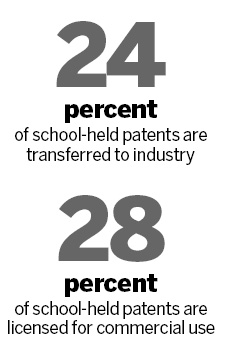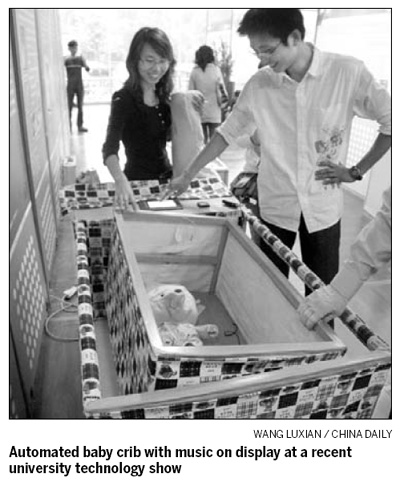Push is on for University Student Inventions

A visitor tries out a student-developed flight stimulator.
Patents from university students most often come as a result of research led by professors, not individual inspiration. Dong Jinlin / China daily
Most often, inventions and patents are not the result of a blinding flash of inspiration by a genius.
Yin Haiyou, a Peking University third-year postgraduate student in microelectronics, said about half the students in his department have applied for patents, many of which the result of research undertaken during their studies.
The master's degree candidate from the School of Electronics Engineering and Computer Science is among them - he has filed for two patents on solar battery innovations.
Patent applications vary by major, said Yan Hui, a doctoral candidate at Tsinghua University.
Not surprisingly, engineering students tend to generate more patents than basic science majors like mathematics.
Few student-developed technologies come from purely personal interest. In most cases they are a by-product of research led by a professor, Yan said.
Yin said his solar battery uses innovations in material and structure he found as a result of his academic research into semiconductor components used in integrated circuits.
To earn a master's or PhD degree, students are required to apply for patents or submit a copy of a published academic paper.
Universities including Peking, Tsinghua and Zhejiang have earmarked a special fund to finance intellectual property projects initiated by their students.
"Nurturing innovation-minded human resources is key to building up an innovation-oriented nation," said Yang Wei, president of Zhejiang University, adding that a university should emphasize that as a fundamental task.
The university topped all higher learning institutions on the mainland in patent applications last year, according to an annual report by the State Intellectual Property Office (SIPO).
Statistics show that many of the top universities for patent applications are clustered around Beijing and the Yangtze River Delta, as are applications from industry.
The reason for the identical pattern is credited to well-established research facilities in the regions, SIPO said.
With more investment in innovation and increased awareness of intellectual property protection, the regions are home to enormous high-tech firms, higher learning institutions and research centers.
About 24 percent of school-held patents have been transferred to industry and 28 percent have been licensed for commercialization.
Promoting cooperation between academic circles and the business world has long been high on the government's agenda, according to SIPO.
With complementary resources, both sides are encouraged to co-establish research and development centers to facilitate industrialization and commercialization of patented technologies.
Governmental aid will tilt toward such joint development projects, SIPO said.


(Source: China Daily)
2013-07-17 Print
Print